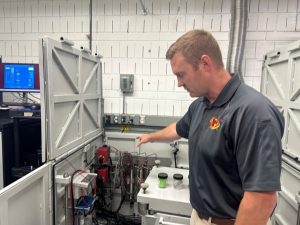Iowa State University to establish battery fabrication, testing center with new equipment
August 11th, 2025 by Ric Hanson
(An article by the Iowa Capital Dispatch) – Iowa State University is charging up to become a destination for academics and industry dealing in battery fabrication and testing, with new equipment opening doors for expanded study of the power source. Todd Kingston, an ISU researcher and assistant professor of mechanical engineering, said the accelerating rate calorimeter system now housed at the university and used for battery testing will hopefully draw in interested students. It would act as a centerpiece of a “shared facility,” where ISU researchers and collaborators can create prototypes and test these and other batteries.
“Various users across campus will have the ability to come in and use that, but we’re hoping to even extend that to partners outside of the university, ones that maybe necessarily don’t have the capabilities or the equipment, or perhaps also the expertise to do some sort of the testing that they want,” Kingston said. “So we can perhaps even work with them to do that testing, provide that expertise, that training … and those resources to them.”

Iowa State University assistant professor Todd Kingston explains the operations of the accelerating rate calorimeter system on Aug. 7, 2025. (Photo by Brooklyn Draisey/Iowa Capital Dispatch.
The new equipment was purchased for the university through grant funding from the U.S. Department of Defense’s Office of Naval Research, which Kingston secured. It took several months to install and integrate into lab infrastructure, he said, but the machinery has been up and running for some time. Both new and used battery cells can be tested with the equipment, Kingston said, allowing researchers to see how they respond under various conditions at different stages of wear. The conditions placed upon the cells can range from electrical to thermal to mechanical, with data being taken on temperature, pressure, voltage, self-heating levels and more in real time.
Batteries are sometimes pushed past their limits as part of testing, Kingston said, leading to their damage or even full destruction. As the batteries are encased in the equipment, researchers can stand just a few feet away and monitor the tests through a computer system. In addition to funding the purchase of the equipment, Kingston said the Office of Naval Research has provided grant dollars to multiple projects that utilize the ARC system and look at metrics associated with batteries and what characteristics can influence their level of safety. One of these projects has ISU researchers testing effects of thermal gradients on battery safety, and another has the university running battery tests to verify predictive modeling for “thermal runaway,” or when a battery goes beyond its limits, developed at the University of Arizona.
There are only a handful of ARC systems currently operating across the U.S., Kingston said, and even fewer are housed in university labs. This allows ISU to conduct research and testing that cannot be done elsewhere due to safety hazards. Joined by other ISU researchers and utilizing internal funding from the Office of the President, Kingston said he is working to create a center where batteries can be crafted and tested on-site. Other equipment is still being installed for the center which will expand the kinds of batteries that can be fabricated. Beyond academic study and potential partnerships with businesses and organizations, Kingston said the new equipment and center for battery testing will be helpful in workforce development, as ISU graduates will head into the world with experiences and skills they would have a hard time finding elsewhere.
More and more students, ranging from their undergraduate to graduate education, are becoming increasingly interested in battery technology, Kingston said, and he hopes the center and its toys will aid in recruitment and retention.


